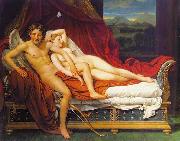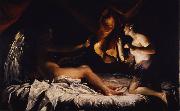Wholesale Oil Painting Reproductions No Minimum and Door to Door! |
|||||||||||
|
|
|||||||||||

|
|||||||||||
|
|
|
||||||||
All Jacques-Louis David Oil Paintings |
||||||||
|
|
||||||||
|
|
||||||||
|
Artist Introduction: Jacques-Louis David, France Neoclassicism painter, b.1748 - d.1835. Jacques-Louis David is famous for his huge, dramatic canvasses of Napoleon and other historical figures, including Oath of the Horatii (1784), Death of Marat (1793) and The Sabine Women (1799). Early in his career he was a leader in the neoclassical movement; later his subjects became more modern and political. David was himself active in the French Revolution as a supporter of Robespierre and is sometimes called the chief propagandist for the Revolution; after the Reign of Terror ended he was briefly imprisoned for his actions. When Napoleon took power David became his court painter and created several grand canvasses of the Emperor, including the heroic Napoleon Bonaparte Crossing the Alps (1801) and the enormous Coronation of Napoleon and Josephine (1807). |
||||||||
|
|
||||||||
|
Cupid and Psyche Painting ID:: 10322 |
1817; Oil on canvas
Cleveland Museum of Art |
|||||||
Height Width |
INS/CM Quality |
|||||||
|
X |
| |||||||
|
|
||||||||
All Giuseppe Maria Crespi Oil Paintings |
||||||||
|
|
||||||||
|
|
||||||||
|
Artist Introduction: 1665-1747
Italian
Giuseppe Maria Crespi Locations
1747). Painter, draughtsman and printmaker. His religious and mythological works are distinguished by a free brushstroke and a painterly manner. He also painted spirited genre scenes, which by their quality, content and quantity distinguish him as one of the first Italian painters of high standing to devote serious attention to the depiction of contemporary life. Such paintings as Woman Laundering (1700-05; St Petersburg, Hermitage) or Woman Washing Dishes (1720-25; Florence, Uffizi) offer straightforward glimpses of domestic chores in images that are startlingly novel for the period and look forward to the art of Jean-Simeon Chardin, Jean-Francois Millet and Honore Daumier |
||||||||
|
|
||||||||
|
|
Cupid and Psyche Painting ID:: 83942 |
from 1707(1707) until 1709(1709)
Medium Oil on canvas
cyf |
||||||
Height Width |
INS/CM Quality |
|||||||
|
X |
| |||||||
|
|
||||||||
All Guillaume Seignac Oil Paintings |
||||||||
|
|
||||||||
|
|
||||||||
|
Artist Introduction: He was born in Rennes, France, in 1870, and died in 1924. He started training at the Academie Julian in Paris, where he spent 1889 through 1895. He had a lot of teachers there, including Gabriel Ferrier, and Tony Robert-Fluery. Tony Robert Fluery was a noted history and genre artist. Gabriel Farrel, on the other hand, had been an awarded Prix de Rome. He had another one named William Bouguereau. |
||||||||
|
|
||||||||
|
|
Cupid and Psyche Painting ID:: 98499 |
oil painting on canvas. |
||||||
Height Width |
INS/CM Quality |
|||||||
|
X |
| |||||||
|
|
||||||||
|
|
||||||||
|
Related Paintings to Guillaume Seignac :. |
||||||||
|
|
||||||||
|
CONTACT US |



